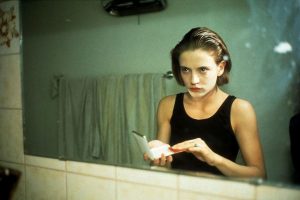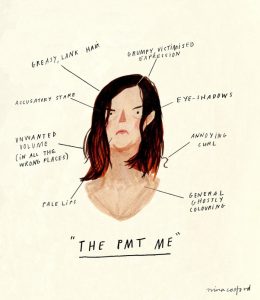‘Amanda in the mirror’ (Goldin, 1992) – technically speaking – isn’t an aesthetically pleasing photograph in the sense that it doesn’t adhere to typical photographic techniques such as rule of thirds, and the setup is unpleasant. The tone is dark and the miserable atmosphere is emphasised by the woman’s demeanour – despite being positioned slightly off centre, her sunken eyes draw our attention and she is visibly scowling.
The photograph appears un-staged and due to the angle of the camera, as a viewer we are made to feel like a fly on the wall which is an interesting perspective. Honesty and spontaneity is common in Goldin’s work, however I favour this image as I believe it provides a relatable stance on femininity. The woman is androgynous in style, her hair is greasy, her face is bare and she isn’t posing. There are hints of post-production editing (vignette etc.) but mostly the photograph is raw – it isn’t pretty, but powerful.
Nina Cosford is an artist who similarly creates relatable illustrations of women in their most vulnerable state. Unlike Goldin’s photograph, the illustration (Cosford, 2016) has a humorous feel to it – the ‘woman’s’ facial expressions are comedic, as is the text ‘PMT me’. The colours are warm and soft which contrast with the previous photo – though despite the light-hearted feel of the image, it is similar in that it doesn’t attempt to glamorise femininity. Another difference is the composition; the female is centre focus in the illustration and her flaws are explicitly stated through hand-written annotation rather than suggested.
PHOTO ONE: Goldin, N. (1992), Amanda in the mirror. Available at: https://images.curiator.com/images/t_x/art/db8d705c1258df7dd1ed939373876b57/nan-goldin-amanda-in-the-mirror-berlin-1992.jpg (Downloaded: 16 October 2017).
PHOTO TWO: Cosford, N. (2016), The PMT Me. Available at: https://s3-eu-west-1.amazonaws.com/betty-me/wp-content/uploads/2016/09/30101135/nin-cosford-PMT.jpg (Downloaded: 16 October 2017).


